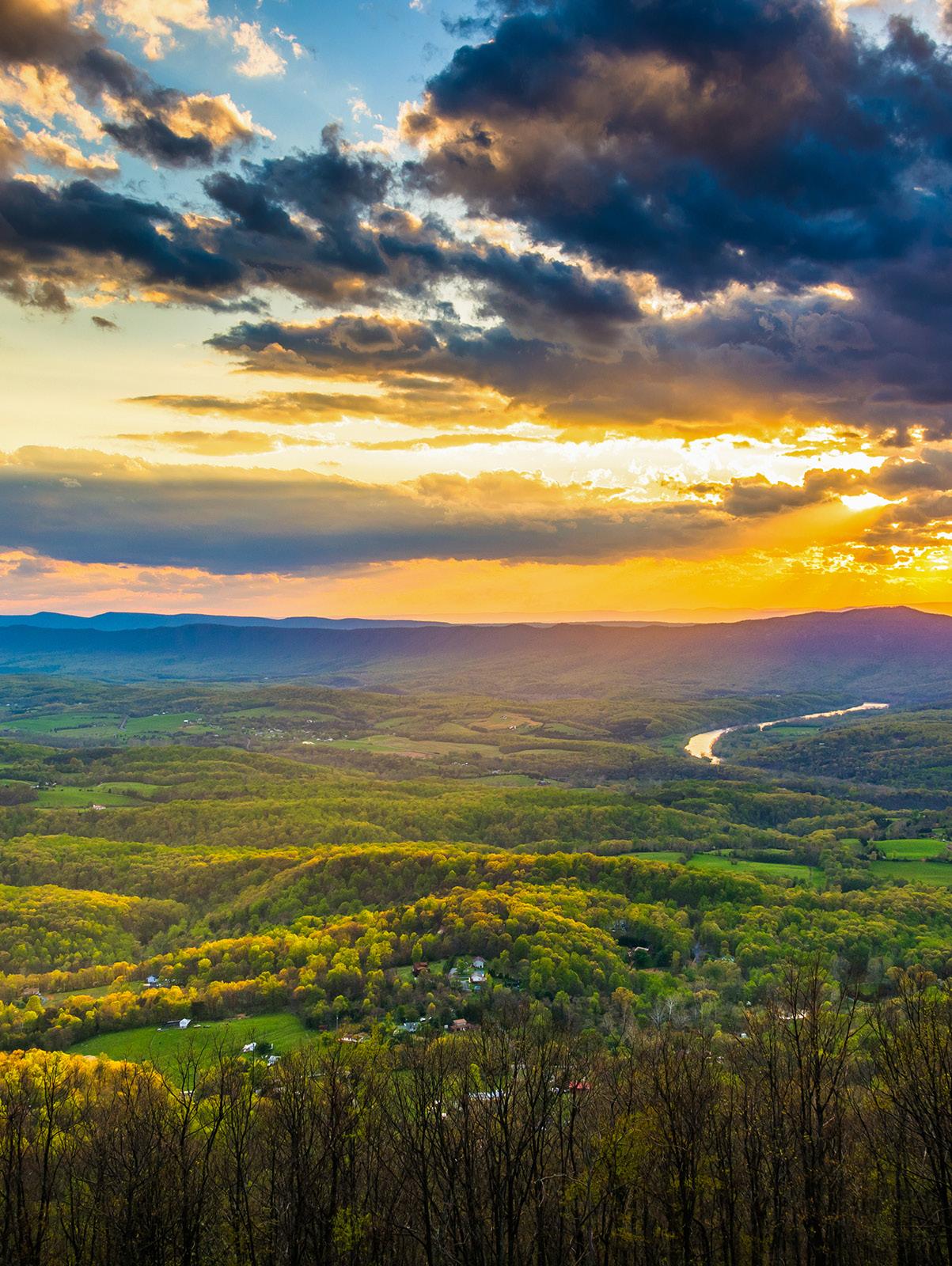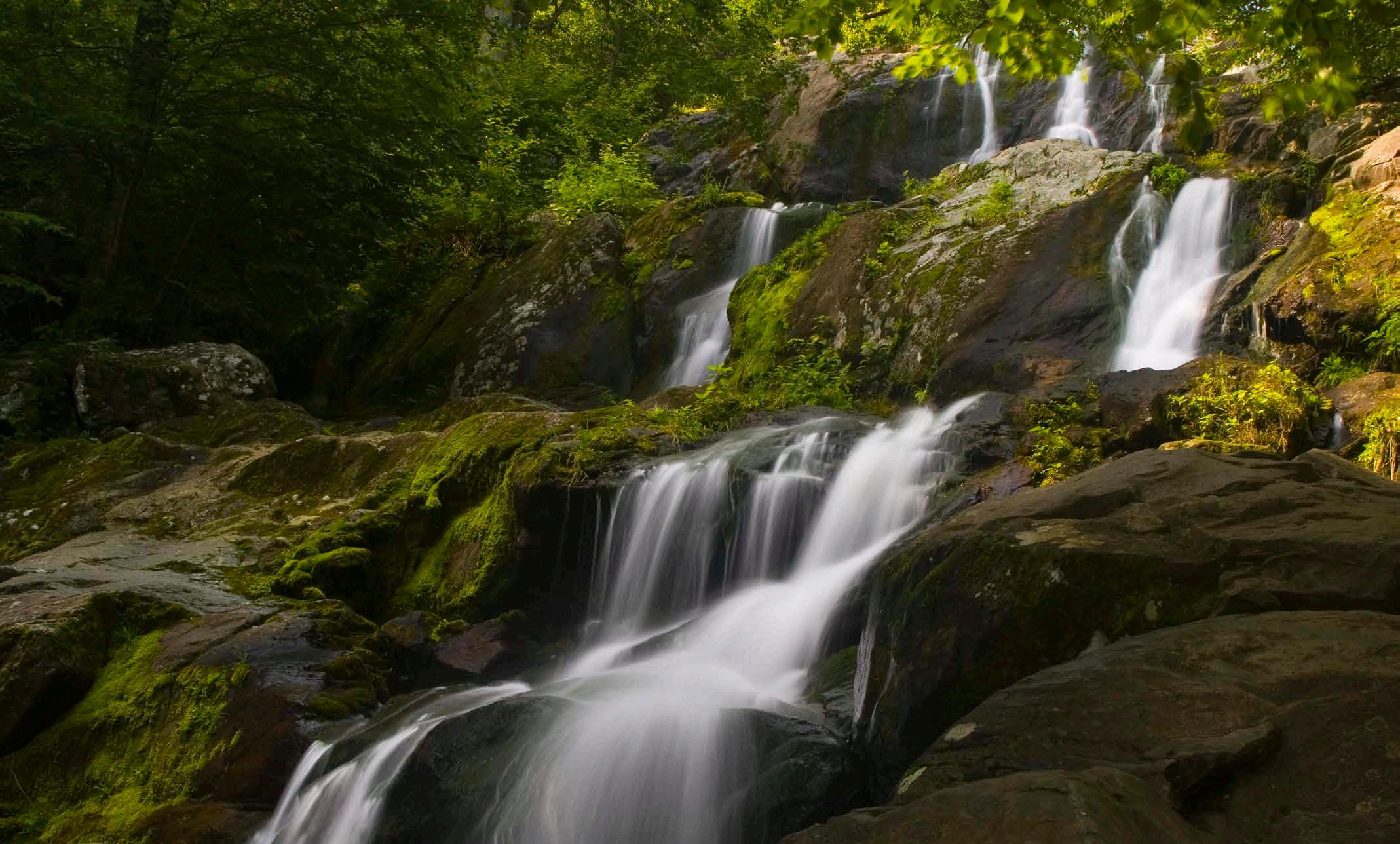
4 minute read
Shenandoah National Park
Just 75 miles — yet worlds away — from Washington, D.C., Shenandoah National Park is a natural playground of plummeting waterfalls, wildflower-stippled meadows, magnificent panoramas and peaceful woodlands echoing with songbirds.
The Blue Ridge Mountains have been occupied by humans for at least 9,000 years, including by the native peoples, who hunted and gathered game, fruit, nuts and berries. Some eventually constructed villages at low elevations in the surrounding Piedmont and Shenandoah Valleys.
By the 1750s, early European settlers moved into the foothills, seeking land to farm, raise livestock and develop orchards. Later, land was purchased to extract resources, such as water, copper and lumber. Resorts were soon built, attracting city dwellers. Eventually, the Civilian Conservation Corps built roads and trails, re-establishing and helping to preserve the wilderness we know today.
Rising above the Virginia Piedmont and the Shenandoah Valley, the national park boasts a range of elevations, rocks and slopes — as well as variable precipitation and latitude — resulting in a diversity of habitats for tens of thousands of living creatures, plants, fungi and lichens.
The Flora And Fauna
As land was cleared and hunting occurred, animal populations in the area decreased, drastically declined or disappeared. Fortunately, over the last century, many of these species returned through natural population recovery or due to re-introduction on Virginian land outside of the park.
Today, Shenandoah is a haven for 190 resident and migratory bird species, 50-plus species of mammal, over 20 reptile and amphibian species, over 40 fish species, and an untold number of spiders, insects and other invertebrates.
From black bears and bobcats hidden deep within forests to rarely seen spotted skunks, shrews, moles and voles; wild turkeys, red-tailed hawks and Carolina chickadees; and reptiles like box turtles and timber rattlesnakes, life unfolds at every turn.

The park’s Mid-Atlantic location rests between the Northern and Southern Appalachian Mountains, allowing 1,400 species of vascular plants to thrive. Cove hardwood and chestnut oak forests are underpinned by jack-in-the-pulpit, ferns, azaleas, blueberries and lady slipper orchids. Moist areas are decorated with mosses and liverworts. Time it right and there are also wildflowers in every imaginable hue, a display that begins in early spring.
The Weather
Warm, humid summers and very cold winters can be expected at Shenandoah, with mountain temperatures usually 10 F cooler than the valley floor. Hottest between late May and mid-September, with average daily highs above 79 F, November through early March sees an average daily high below 53 F. January, the coldest month of the year, has an average low of 26 F and high of 45 F. Sprawling across roughly 100 miles, Shenandoah’s temperatures vary considerably. Dress accordingly and check the park’s website for the latest weather, trail and road conditions.
The Hikes, Drives and Viewpoints
Old Rag Mountain Loop
Among the park’s most popular and rigorous hikes, the 9.3-mile Old Rag Mountain Loop requires both caution and an adventurous spirit, for which hikers are rewarded with rock scrambles and 360-degree views.
Dark Hollow Falls Trail
The 1.6-mile Dark Hollow Falls Trail follows a stream and features a steep descent to — and rocky, slippery climb up from — the cascades.

Hawksbill Summit Trail
A short — and steep — trek to Shenandoah’s highest peak, the 1.6mile Hawksbill Summit Trail wows with
360-degree vistas of the Shenandoah Valley, Blue Ridge Mountains and Virginia’s Piedmont region.
Stony Man Loop Via The Appalachian Trail
Near the town of Syria, Virginia, the 1.6-mile Stony Man Loop via the Appalachian Trail delivers magnificent views of the Shenandoah Valley, Massanutten Mountain and scenic land beyond.
Skyline Drive
The only public road through the park runs 105 miles north and south along the crest of the Blue Ridge Mountains, amid a vast network of trails that includes a section of the fabled Appalachian Trail. Journeying to awe-inspiring overlooks and through untamed wilderness, it’s a destination in its own right.
About The Park
Location - Virginia's Blue Ridge Mountains
Established - December 26, 1935
Area - 198,000 acres










